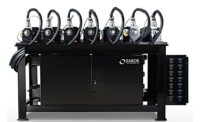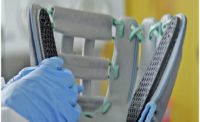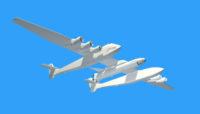Barring any obstacles, the Dream Chaser spaceplane will make its initial orbital test flight on Nov. 1, 2016. The craft will launch on an Atlas V412 rocket from Kennedy Space Center in Merritt Island, FL—more than 12 years after it was first announced as a candidate for NASA’s Vision for Space Exploration program.
Owned and operated by Sierra Nevada Corp. (SNC), Dream Chaser is a reusable, lifting-body vehicle that lands horizontally and can be operated with or without crew. It is designed as a space utility vehicle for orbital and suborbital (maximum speed below orbital velocity) flight to destinations such as the International Space Station.
The vehicle carries from two to seven people and cargo, flies autonomously if needed and features a built-in launch escape system. Unlike all other spacecraft, the Chaser glides back to earth (typically experiencing less than 1.5 g-force on re-entry) and lands on any airport runway that handles commercial air traffic.
Because its reaction-control-system thrusters burn ethanol-based fuel, which is not explosive, the Chaser can be handled immediately after landing. The vehicle’s thermal protection system is an ablative tile (rather than individual tiles) that is easily replaced after several flights.
In-orbit propulsion is provided by twin hybrid rocket engines that are fueled with hydroxyl-terminated polybutadiene and nitrous oxide. Both substances are nontoxic, easily stored and safer than liquid rocket fuels. They also allow the engines to stop and start repeatedly, and be throttle controlled.
Recently, SNC hired the Southwest Research Institute (SwRI) to design and build the Chaser’s atmospheric flight control system. To verify proper operation of the flight controls, SwRI uses a customized DynoLAB test system.
Made by SAKOR Technologies Inc., DynoLAB determines the flight control system’s response to physical forces typically experienced in standard and extreme flight conditions. The system simulates the Chaser’s entire flight—from atmospheric interface to landing—and uses seven dynamometers to monitor the Chaser’s seven control surfaces.
During simulation, the system sends test profiles to the flight controller and receives feedback data from each control surface via a bus that meets the MIL-STD-1553B standard.
DynoLAB comes in two standard versions. The PT series is specifically configured with the capability to fully automate all aspects of engine and powertrain dynamometer testing. It seamlessly integrates any type of dynamometer, sensor, instrumentation and support equipment into a test cell.
The EM version, when combined with one or more AccuDyne AC dynamometers, tests the mechanical and electrical characteristics of all types of motors, generators, inverters and electromechanical devices. It also is part of SAKOR’s hybrid vehicle powertrain dynamometer test system for drivelines, subsystems and components.
SAKOR Technologies develops and manufactures automated test instrumentation systems for a wide range of applications. The company has provided products for companies in the automotive, military, aerospace, marine, heavy equipment, electric motor, performance racing and consumer-appliance industries.
For more information on test instrumentation systems, call 517-332-7256, or visit www.sakor.com.





